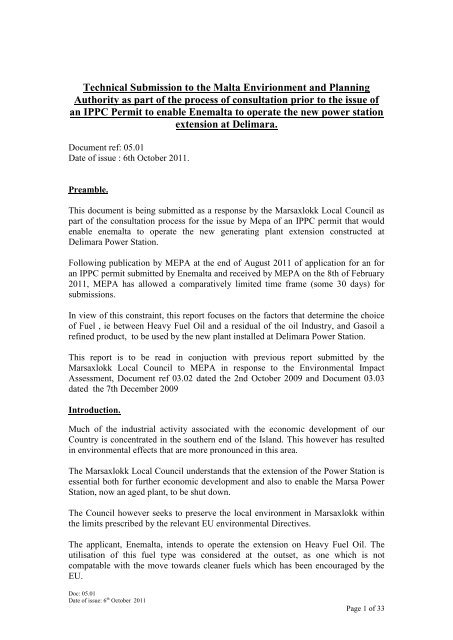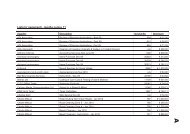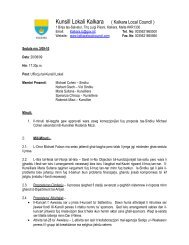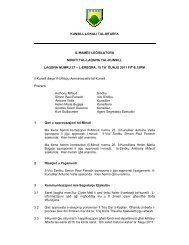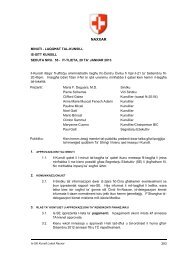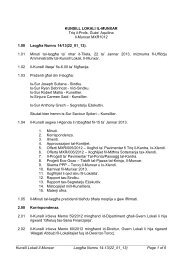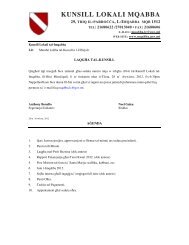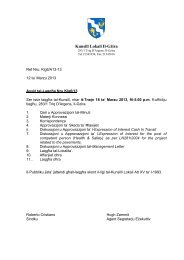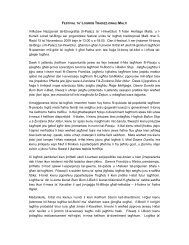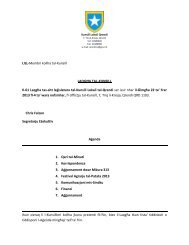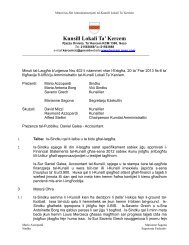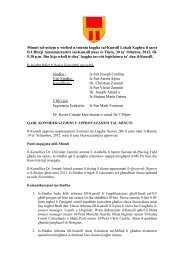Air Quality - lc.gov.mt
Air Quality - lc.gov.mt
Air Quality - lc.gov.mt
- No tags were found...
Create successful ePaper yourself
Turn your PDF publications into a flip-book with our unique Google optimized e-Paper software.
Technical Submission to the Malta Envirionment and PlanningAuthority as part of the process of consultation prior to the issue ofan IPPC Permit to enable Enemalta to operate the new power stationextension at Delimara.Document ref: 05.01Date of issue : 6th October 2011.Preamble.This document is being submitted as a response by the Marsaxlokk Local Council aspart of the consultation process for the issue by Mepa of an IPPC permit that wouldenable enemalta to operate the new generating plant extension constructed atDelimara Power Station.Following publication by MEPA at the end of August 2011 of application for an foran IPPC permit submitted by Enemalta and received by MEPA on the 8th of February2011, MEPA has allowed a comparatively limited time frame (some 30 days) forsubmissions.In view of this constraint, this report focuses on the factors that determine the choiceof Fuel , ie between Heavy Fuel Oil and a residual of the oil Industry, and Gasoil arefined product, to be used by the new plant installed at Delimara Power Station.This report is to be read in conjuction with previous report submitted by theMarsaxlokk Local Council to MEPA in response to the Environmental ImpactAssessment, Document ref 03.02 dated the 2nd October 2009 and Document 03.03dated the 7th December 2009Introduction.Much of the industrial activity associated with the economic development of ourCountry is concentrated in the southern end of the Island. This however has resultedin environmental effects that are more pronounced in this area.The Marsaxlokk Local Council understands that the extension of the Power Station isessential both for further economic development and also to enable the Marsa PowerStation, now an aged plant, to be shut down.The Council however seeks to preserve the local environment in Marsaxlokk withinthe limits prescribed by the relevant EU environmental Directives.The applicant, Enemalta, intends to operate the extension on Heavy Fuel Oil. Theutilisation of this fuel type was considered at the outset, as one which is notcompatable with the move towards cleaner fuels which has been encouraged by theEU.Doc: 05.01Date of issue: 6 th October 2011Page 1 of 33
The Council maintains that some of the pollutants that under present conditions,without the power station extension in operation, already exceed the limits imposedby the Clean <strong>Air</strong> Directive 2008/50/EC. This concern regards specifically ParticulateMatter PM 10 and PM 2.5 both considered to endanger human health, and particularly thelatter being regarded by the same Directive as responsible for significant negativeimpacts on human health.The Council, in its previous submission had specifically requested MEPA to establish<strong>Air</strong> <strong>Quality</strong> Monitoring Stations in Marsaxlokk and to determine, through precisemeasurements taken from air quality monitoring stations that had to be established inMarsaxlokk and Birzebbugia, the level of pollutants particularly PM 2.5 , PM 10, NO 2,SO 2 and Heavy Metals and to determine if these fall within acceptable limits. (Appendix A1)Once more,despite that the attention of MEPA was drawn by the Marsaxlokk LocalCouncil,, no long term measurements were made by MEPA in this respect, although24 months from the request made by the Council have since elapsed.Only measurements taken over a 4 week period as part of the process to establish thesecond air dispersion model are available. These indicate unequivocably, that thelevels of PM 2.5 and PM 10 exceed significantly, the limits established in the Clean <strong>Air</strong>Directive 2008/50/EC.The situation is one where MEPA is being ask to grant a permit for the operation ofnew power station plant, utilising Heavy Fuel Oil as a primary fuel source, in anenvironment that is already polluted beyond established limits.This report :1. Analyses the results of the measurements made by ESS Gmbh & Ecoserve,that show that the present pollution levels particularly for particulate matterPM2.5 in Marsaxlokk and Birzebbugia exceed significantly the limitsstipulated by Directive 2008/50/EC – The clean air Directive, and that MEPAis obliged by the same Directive to take all actions necessary to reduce thelevels of this pollutant below that stipulated in the Directive. This means thatMEPA can only permit the combustion of Gasoil a much cleaner fuel than thepolluting Heavy Fuel Oil.2. Compares the prices of generation of electrical energy at the Marsa PowerStation operating on Hevay Fuel Oil with that generated at the DelimaraPower Station Extension (DPSE) utilising Gasoil, and shows that if Gasoilwere to be used to fuel the Delimara Extension Plant the price of electricalEnergy will be actually cheaper than that currently produced at Marsa.3. Interprets the report by Cubed Consultants and shows that also this reportindicates that the operation of the plant on Gasoil other than Heavy Fuel Oiloffers under present conditions the best performance.Doc: 05.01Date of issue: 6 th October 2011Page 2 of 33
4. Comments on the Stacks that have been constructed by Enemalta without therequiste permission from MEPA, and states that in view of the fact that theemissions from the Stacks which are 65m high contribute to a significantdegree to the atmosphere in Marsaxlokk, which is already overloaded withParticulate Matter pollution if Heavy Fuel Oil were to be burnt , then MEPAhas in this case also no other alternative but to permit Enemalta to operate theplant of Gasoil.This report concludes, that in view of the excessive PM 2.5 levels in Marsaxlokk andBirzebbugia, that the unit cost of electrical energy generated at DPSE utilising Gasoilwill actually be cheaper than the unit cost of energy currently generated at MarsaPower Station, and that also the report by Cubed Consultants concludes that Gasoilover a better performance over Heavy Fuel Oil , than MEPA is left with no otheroption but to permit the Delimara Power Station Extension DPSE to operate only onGasoil.-------------------------Ing. Arthur Ciantar.Resident and Consultant toThe Marsaxlokk Local CouncilDoc: 05.01Date of issue: 6 th October 2011Page 3 of 33
SECTION AAIR QUALITYDoc: 05.01Date of issue: 6 th October 2011Page 4 of 33
<strong>Air</strong> <strong>Quality</strong>.1.0 Background.The Marsaxlokk Local Council (MLC) in its submission refer 03.02 dated the 2 ndOctober, had presented an analysis of the <strong>Air</strong> <strong>Quality</strong> Assessment presented as part ofthe Environment Impact Assessment.The Marsaxlokk had already presented at the time, early in the process, a number ofconcerns and had requested MEPA to investigate and determine: ( Appendix A1)1. That all analysis shall satify the stipulations of Directive 2008/50/EC thatcame into force on the 11th June 2010.2. The validity of the extrapolation of information from the Zejtun monitoringstation to estimate the final conditions in Marsaxlokk once the plant is inoperation, taking into account also the relative position of the monitoringstation with respect to theplant and the prevailing winds.3. The levels of all pollutants particulary PM 2.5, PM 10 , NO 2 , SO 2 and heavymetals particularly on the populations of Marsaxlokk and Birzebbugia basedon the actual current background levels in both locations, and to determine ifthese fall within acceptable limits.It is to be mentioned that MEPA has categorically stated that quote“MEPA is particularly concerned about the PM issue, since this pollutant is amajor air quality concern for Malta.” ( Appendix A2)Unquote.Additionally the Marsaxlokk Local Council had requested the establishment ofan <strong>Air</strong> <strong>Quality</strong> Monitoring Station in Marsaxlokk4. The emissions and the environmental impact if the proposed plant is fuelledwith Gasoil / Light distillate instead of Heavy Fuel Oil.It is pertinent to indicate that the values PM 2.5 measured at the Zejtun MonitoringStation in 2008 and presented in the report by AIS Environmental already exceededthe limit values stipulated in the Clean <strong>Air</strong> Directive now in force.It is to be mentioned here that pollutants PM 2.5, and PM 10 were not taken into accountin the Stack Height Determination, and this will certainly have a signifcant influenceon the concentration of these pollutants in the area.An important point on the issue of <strong>Air</strong> <strong>Quality</strong> was raised by the Council is thatBWSC had submitted emission limit related figures that it refused to Guarantee, andDoc: 05.01Date of issue: 6 th October 2011Page 5 of 33
that there remain strong doubts on the operation of the “prototype plant “ and theeffectiveness of flue gas cleaning systems.The Marsaxlokk Local Council gave notice both to MEPA and AIS Environmentalthat since the <strong>Air</strong> <strong>Quality</strong> Assessments is based on emission values that are notguaranteed by BWSC at the time of submission of their Tender for the Plant, theCouncil considers the <strong>Air</strong> Quailty Assessment to be seriously compromised if not alsoinvalid.It is also evident from the report presented by the Auditor General that the issue ofemissions remains a point of contention.2.0 Particulate Matter PM 2.5The <strong>Air</strong> <strong>Quality</strong> Assessment presented as part of the EIA showed in Table 4-2Background Concentrations – Real Time Station , that the annual average of PM 2.5measured in 2008 at Zejtun was 22.8 μg/m 3 . (Appendix A3)The values of PM 2.5 at the Zejtun Monitioring Station in 2008 and presented in thereport by AIS Environmental already exceed the upper assessment threshold of17μg/m 3 as stipulated in Annex II , A.3 of Directive 2008/50/EC ( Appendix A4)Furthermore with respect to PM 2.5 Article 15 of the Clean <strong>Air</strong> Directive stipulates(Appendix A6):1. Member States shall take all necessary measures not entailing disproportionatecosts to reduce exposure to PM 2.5 with a view of attaining the national exposurereduction target laid down in Section B of Annex XIV by the year specified therein.(Appendix 5.1)The article continues under point 22. Member States shall ensure that the average exposure indicator for the year 2015established in accordance with Section A of Annex XIV does not exceed the exposureconcentration obligation laid down in Section C of that Annex. ( ie 20 μg/m 3 by 2015).This is an exposure concentration obligation.Also, regarding the same emission (PM 2.5 ) Article 16 of the same directive stipulates( Appendix A6):Member States shall take all necessary measures not entailing disproportionate coststo reduce exposure to PM 2.5 with a view of attaining the national exposure reductiontarget laid down in Section B of Annex XIV by the year specified therein, ( ie 18 μg/m 3by 2020). This is the target value and limit value for the protection of human health.MEPA therefore has an irrevocable obligation to see that the stipulations set byDirective 2008/50/EC for PM 2.5 met within the time limits specified.Doc: 05.01Date of issue: 6 th October 2011Page 6 of 33
As the annual mean concentrations of PM 2.5 at the Zejtun Monitioring Stationrecorded in 2008 and presented in the report by AIS Environmental, recorded at 22.8μg/m 3 exceeded the upper assessment threshold of 17μg/m 3 ( Appendix A6), theMarsaxlokk Local Council in its submission ref 03.02 October 2009 placed a numberof questions to MEPA . ( Appendix A7)The questions regarding this issue are1. (What led to this unusual , disparate and diverging result ??)- refers to AIS2. Were actual long term PM 2.5 levels measured both at Marsxlokk andBirzebbugia.3. If these measurements were made what are the results ?4. How will the present measured levels at Marsaxlokk and Birzebbugia beaffected once the new plant is put in service operation.5. Will the PM 2.5 levels particularly those in Marsaxlokk and Birzebbugia exceedpermissible limits once the proposed plant burning heavy fuel oil is put inoperation.6. How will the PM 2.5 levels particularly those in Marsaxlokk and Birzebbugiadecrease if the height of the exhaust stacks is higher than 50m as proposed,with the plant burning heavy fuel oil.7. What will be the optimum Stack height that will result in the minimumpossible PM 2.5 levels from the exhaust gas stream in Marsaxlokk andBirzebbugia.It appears that at the time the questions were submitted, MEPA may not have been ina position to answer the questions raised above.On the basis that the <strong>Air</strong> <strong>Quality</strong> Assessment carried out in the first instance wasbased on data obtained from the <strong>Air</strong> Monitoring Station at Zejtun, the MarsaxlokkLocal Council requested the installation of an <strong>Air</strong> <strong>Quality</strong> Monitoring Station inMarsaxlokk and possibly in Birzebbugia with the purpose of obtaining a precisemeasurement of the level of pollutants particularly of PM 2.5 levels.More over the Marsxlokk local Council had requested MEPA to investigate anddetermine ( amongst others); (Appendix A1.2)“the levels of all the pollutants particularly of the PM 2.5 , PM 10 , NO 2 , SO 2 andheavy metals particularly on the populations of Marsaxlokk and Birzebbugia,based on the actual current background levels in both locations, and to determineif these fall within acceptable limits.”Despite that approximately 2 years have elapsed since the requests sub<strong>mt</strong>ted by theMarsaxlokk Local Council were placed, MEPA has not yet provided any answers onthis pivotal question.Doc: 05.01Date of issue: 6 th October 2011Page 7 of 33
3.0 PM 2.5 concentrations measured by ESS GMBH and Ecoserv.Following a call for tenders issued by MEPA on the 1 st April 2010, MEPAcommissioned ESS Gmbh and Ecoserv Ltd to carry out <strong>Air</strong> Dispersion Modelling ofNO 2, PM 10 , PM 2.5 , Metals and Benzo-a-pyrene,from Delimara Power Station.As part of the exercise within their remit, ESS Gmbh and Ecoserv established two airmonitoring stations, one in Marsaxlokk and one in Birzebbugia with the scope ofobtaining accurate measurements of the pollutants under study. These measurementswere then to be used as actual measured data together with data gathered from othersources to establish the mathematical models.The values measured at Marsaxlokk and Birzebbugia for PM 2.5 shown in Table 9( page 17) ( Appendix A8) of the report by ESS and Ecoserv are reproducedhereunder.PM 2.5 daily annual average target value (20100101) : 25μg/m 3Monitoring Avg. μg/m 3 max. μg/m 3 N of obs From ToStationMarsaxlokk 52.70 149.00 29 18/04/2011 16/05/2011Birzebbugia 34.70 61.00 29 18/04/2011 16/05/2011The measured values show that over a period of nearly one Month, the average dailyvalue of the concentration of PM 2.5 in Marsaxlokk is 52.70 μg/m 3 ,which represents anexcess of over 100% over the present annual average target value of 25μg/m 3The peak value is by the same measure even more alarming in that the valuemeasured, 149 μg/m 3 , represents an excess of nearly 500% over the present targetvalue of 25μg/m 3The same may be said, to apply, albeit at a lesser degree of the respective valuesmeasured at Birzebbugia.The magnitude of the results of the samples taken at random over the period indicatedshow in the most irrefutable manner, that not only do the values not fall within thestipulations of the Clean <strong>Air</strong> Directive but that the stipulated target values areexceeded by several orders of magnitude.Under such circumstances Article 23 of Directive 2008/50/EC stipulates that(Appendix A9):“Where, in given zones or agglomerations the levels of pollutants in ambient airexceed any limit values or target value, plus any relevant margin of tolerance in eachcase, Member States shall ensure that air quality plans are established for those zonesand agglomerations in order to achieve the related limit values or target valuespecified in Annexes XI and XIV”This obligation falls on MEPA , one that has as yet to materialise.Doc: 05.01Date of issue: 6 th October 2011Page 8 of 33
4.0 Description of the situation.The situation may be best described as a scenario where Enemalta wishes to operatean extension to the Delimara Power station utilising Heavy Fuel Oil as the primaryfuel source in an environment, in which the limits for at least PM 2.5 , today without theextension plant in operation, have been exceeded.It is pertinent to quote the description covering Particulate Matter PM2.5 given in theClean <strong>Air</strong> Directive:Regarding PM 2.5 emissions Directive 2008/50/EC preamble para 11. States (AppendixA10):Fine particulate matter (PM 2.5 ) is responsible for significant negative impacts onhuman health. Furthermore, there is as yet no identifiable threshold below whichPM 2.5 , would not pose a risk. As such this pollutant should not be regulated in thesame way as other air pollutants. The approach should aim at a general reduction ofconcentrations in the urban background to ensure that large sections of the populationbenefit from improved air quality. However to ensure a minimum degree of healthprotection everywhere, that approach should be combined with a limit value, which isto be preceded in a first stage by a target value.The description clearly encompasses the following principles:1. Particulate matter (PM 2.5 ) is responsible for significant negative impacts on humanhealth2. That there is no identifiable threshold below which PM 2.5 , would not pose a risk3. That this pollutant should not be regulated in the same way as other air pollutants.4. That the approach should aim at a general reduction of the concentrations in theurban background to ensure that large sections of the population benefit fromimproved air quality.Of the four principles, it is the fourth that is determinant, by the fact that the Directiveitself that the approach should be to aim at a general reduction of the concentrations inthe urban background.The fact that it may be assumed that the greater part of the pollution related toparticulate matter may in fact be related to other sources such as vehicle emissions,and not to the operation of the Power Stations does not diminish in any way the aimof this principle, but quite on the contrary, reinforces the purpose of the sameobjective. For if the environment is polluted beyond limits stipulated in the directive,then the aim of achieving a general reduction of the concentration in the urbanbackground should include also, amongst other measures, the imperative thatEnemalta should use the best available technology coupled with the cleanest fuel thatmay, under present circumstances be delivered to Delimara Power Station.Doc: 05.01Date of issue: 6 th October 2011Page 9 of 33
The use of Diesel Engines with an average efficiency of 46% represents what ispossibly one of the most efficient combustion technologies available today. The issuesthat arise do not concern the plant itself but rather the fuel that shall be used to operateit.Enemalta is proposing to utilise Heavy Fuel Oil as the primary fuel source, and alsoGasoil as a secondary fuel Gasoil is required during the starting phase and even moreduring the shutdown phase of the plant, as otherwise the heavy fuel oil, which oncooling down would be very viscous, would as a result block the fuel delivery lines.The Marsaxlokk local council had in its submission 03.02 dated the 2 nd October,presented a table comparing the increases in the emissions resulting from theproposed plant fuelled with Heavy Fuel Oil.The data is extracted from Table 5.3– presented in the EIS as shown in AppendixA11, and is being reproduced hereunder from page 13 ( Appendix A12) of report03.02 presented by the council.Table 5.3 in particular shows the following increases:PollutantPhase1Phase2aPhase2bTotal PresentEmission ProposedIncrease inEmissionFuelHFOLightDistillateLightDistillateHFOPM2.5 (g/s) 4.9 0.7 0.7 6.3 4 63.49%Pb (mg/s) 1.8 1.5 1.5 4.8 1.5 31.25%Cd (mg/s) 0.5 0.5 0.5 1.5 0.4 26.67%Hg (mg/s) 0.2 0.3 0.3 0.8 0.1 12.50%As (mg/s) 1.6 0.4 0.4 2.4 1.3 54.17%Cr (mg/s) 1 1.2 1.2 3.4 0.8 23.53%Cu (mg/s) 2.1 0.6 0.6 3.3 1.8 54.55%Ni (mg/s) 102.5 0.3 0.3 103.1 84 81.47%Se (mg/s) 0.8 1.6 1.6 4 0.7 17.50%Zn (mg/s) 35.3 0.4 0.4 36.1 28.9 80.06%PaH (mg/s) 2.6 0.2 0.2 3 2.1 70.00%V (mg/s) 922.2 2.8 2.7 927.7 755.4 81.43%The table shows that the utilisation of Heavy Fuel Oil (HFO) to fuel the newextension will result in a further increase of 63.49% in PM 2.5 emission over thosefrom the plant presently in operation ( Phases 1, 2a,& 2b).For the sake of comparison, let it be assumed that the new plant will be fuelled withGasoil / Light Distillate utilising the same values quoted for Phase 2a and 2b GasTurbines, as follows;Each of the Gas Turbines installed on Phase 2a and 2b each have a rating of 37 MW.Estimating the output of the extension with a basis of 132 MW ( 12 MW being due tothe heat recovery steam turbine),Doc: 05.01Date of issue: 6 th October 2011Page 10 of 33
PollutantPhase1Phase2aPhase2bTotal PresentEmission132MWExtensionIncrease inEmissionFuelHFOLightDistillateLightDistillateLightDistillate EstimatedPM2.5 (g/s) 4.9 0.7 0.7 6.3 2.49 39.52%The value of 39.52% increase in PM 2.5 emission represents a decrease of 37.75%when compared to the resulting PM 2.5 emission resulting from the combustion ofheavy fuel oil.In reality the efficiency of the Diesel Engines installed is quoted at some 46% whilethat of a Gas Turbine is approximately 33% and therefore the actual increase in PM 2.5emission will be lower than that indicated above.The above estimate is in agreement with the reply received from Enemalta to aquestion raised by MEPA on the same subject, during the process leading to the issueof the full development permit. ( Appendix A13)To the question raised by MEPA asking;“ the emissions that would result if the proposed plant were to be fuelled with Gasoil/ Light distillate which has significantly lower sulphur content, instead of the 1%Sulphur heavy fuel oil”Enemalta replied:“SO 2 emissions shall be reduced by half of the values above with operation on gasoil.This is because the emission limit values specified are equivalent to operating theplant on fuel containing 0.2% sulphur while gasoil contains 0.1%. Thus the annualSO 2 emissions shall be 435 Tonnes for base load operation and 300 Tonnes for 2shifting operation (same conditions as above).NOx emissions are not expected to be affected. Dust emissions are also expected todecrease by approximately 40%. CO emissions are between 0.02 and 0.09% byvolume. This value also includes THC VOCs. No further information is available onCO emissions.” ( Appendix A13)Even Enemalta accepts that the utilisation of Gasoil instead of Heavy Fuel oil willresult in a significant decrease in dust/particulate matter emissions.3.0 PM 10 concentrations measured by ESS GMBH and Ecoserv.The measurements of the of the PM 10 concentrations at Marsaxlokk and Birzebbugia,as with PM 2.5 , show clearly exceedances over the limits stipulated in Directive2008/50/EC.Doc: 05.01Date of issue: 6 th October 2011Page 11 of 33
PM 10 dailyMonitoring Avg. μg/m 3 max. μg/m 3 N of obs From ToStationMarsaxlokk 54.10 154.00 29 18/04/2011 16/05/2011Birzebbugia 70.00 250.00 29 18/04/2011 16/05/2011Section 3 of Annex II of Directive 2008/50/EC establishes upper assessment thresholdfor PM 10 concentrations as follows.( Appendix A6/1)24-hour average : 35 μg/m 3 not to be exceeded more than 35 times in any calendaryear.Annual average : 28μg/m 3The PM 10 concentrations obtained within the sample period, even when one considersthat 29 samples over a practically a month is only 6 samples short of the 35 in acalendar year, clearly show that the values measured exceed significantly the tresholdlevels.Furthermore section B of Annex XI of Directive 2008/50/EC establishes thefollowing PM 10 concentration limit values for the protection of human health(Appendix A14)One day: 50 μg/m 3 not to be exceeded more than 35 times in any calendar year.Calendar year: 40μg/m 3These limit values have been in force since 2005.Article 23 clause 1 of Directive 2008/50/EC ( Appendix A9/1) stipulates that:“Where, in given zones or agglomerations the levels of pollutants in ambient airexceed any limit values or target value, plus any relevant margin of tolerance in eachcase, Member States shall ensure that air quality plans are established for those zonesand agglomerations in order to achieve the related limit values or target valuespecified in Annexes XI and XIV”MEPA is obliged to respect this directive with respect to PM 10 also.It is somewhat strange that the Marsaxlokk local Council has to emphasise theobligation regarding the application of the Directive 2008/50/EC in the reduction ofPM10 levels. (Appendix A14).Indeed in 2010 MEPA had prepared an <strong>Air</strong> <strong>Quality</strong> Plan for the Office ofthe PrimeMinister, with the precise scope of achieving reductions in the daily average levels ofPM 10 for which exceedances have been recorded since 2004. ( Appendix A14)The precise scope of the Action Plan was “aimed at ensuring compliance with thePM 10 daily limit value by June 2011” ( Appendix A15/2).Doc: 05.01Date of issue: 6 th October 2011Page 12 of 33
At the time of writing of this Document, now October 2011, 4 months after thedeadline stated in the <strong>Air</strong> <strong>Quality</strong> Plan, significant exceedances in the levels of PM 10are still being recorded at least in Marsaxlokk and Birzebbugia as measured by ESSGmbh and Ecoserve. Clearly the aim of the <strong>Air</strong> <strong>Quality</strong> Plan has not been achieved.Moreover, in this same scenario, Enemalta is requesting permission from MEPA tooperate the Delimara Power Station Extension (DPSE) on Heavy Fuel Oil therebyfurther generating substantial amounts of PM 10 particulate matter.This state of affairs allows MEPA to permit Enemalta to operate the plant on Gasoilonly, as a measure to reduce the exceedances in the recorded levels of PM 10 .Conclusion.Whereas1. the Clean air Directive 2008/50/EC states; “ that particulate matter PM 2.5 isresponsible for significant negative impacts on human health. Further, there is as yetno identifiable threshold below which PM 2.5 , would not pose a risk. As such thispollutant should not be regulated in the same way as other air pollutants. Theapproach should aim at a general reduction of concentrations in the urbanbackground to ensure that large sections of the population benefit from improved airquality. However to ensure a minimum degree of health protection everywhere, thatapproach should be combined with a limit value, which is to be preceded in a firststage by a target value.”2. The measurements taken on 29 separate occasions at the Marsalokk air monitoringstation, established by MEPA, independently verified the extremely high levels ofPM2.5 particulate matter which exceed the average annual level stipulated by theClean air Directive,3. That despite the fact the the levels of PM2.5 exceed the the target valuesestablished in Directive 2008/50/EC no <strong>Air</strong> <strong>Quality</strong> Plans as stipulated in Directive2008/50/EC, preamble clause 18, and Article 23 , and further more that no short termaction plans have been prepared to reduce the levels of PM2.5 to a reduce the risk orduration of the exceedance as stipulated by Article 24 of the same Directive, thisbeing the the sole responsibilty of MEPA,4.The utilisation of Gasoil instead of Heavy Fuel Oil to fuel the extension, will resultin a decrease of approximately 37.75% in PM2.5 emissions.5.The measurements taken on 29 separate occasions at the Marsxlokk air monitoringstation, established by MEPA, independently indicated that the levels of PM 10 exceedthe average annual level stipulated by Directive 2008/50/EC.6.That despite the fact the the levels of PM10 exceed the the target values establishedin Directive 2008/50/EC no <strong>Air</strong> <strong>Quality</strong> Plans as stipulated in Directive 2008/50/EC,Doc: 05.01Date of issue: 6 th October 2011Page 13 of 33
preamble clause 18, and Article 23 , and further more that no short term action planshave been prepared to reduce the levels of PM10 to reduce the risk or duration of theexceedance as stipulated by Article 24 of the same Directive, again the soleresponsibility of MEPA7.That the <strong>Air</strong> <strong>Quality</strong> Plan prepared by MEPA in line with Directive 1999/30/EC toachieve a reduction in the levels of PM 10 , with which levels of exceedances havebeen recorded since 2004, has not achieved its target, and that exceedances in thelevels of PM 10 are still being recorded today.8.That the samples taken during the latest study by ESS Gmbh and Ecoserv Ltd at theMarsaxlokk and Birzebbugia were limited to 29 just 6 samples less than thosementioned in the Directive is certainly no fault of the Marsaxlokk Local Council,which had previously called at the permitting stage for long term measurments of thepollutants in the environment at Marsaxlokk and Birzebbugia. It was MEPA thatissued the tender, and therfore it was the sole responsibilityof MEPA to see to thismatter.9.That Marsaxlokk Local Council in October 2009 had requested to MEPA toinvestigate and determine ( Appendix A1/2)The levels of the pollutants particularly of PM 2.5, PM 10 , NO 2 , and SO 2 , and heavymetals particularly on the populations of Marsaxlokk and Birzebbugia, based onthe actual current levels in both locations and to determine if these fall withinacceptable limits.The levels of NO 2 and SO 2 at Marsaxlokk and Birzebbugia were not measured.This inspite of the fact that the Clause 4.4.2 Para 2 ( Appendix A16) from theEnvironment Impact Assessment presented by AIS Environmental in 2008 statedthat:“...it is evident that the baseline concentrations for NO 2 and SO 2 vary widelyacross the study area from the urban background locations to roadside locations.Monitoring of NO 2 indicates exceedences of the limit value at some urban areas inthe study area”In view of the results obtained from the Environmental Impact Assessmenttogether with the number of observations raised by the Marsaxlokk local Counciland other enities and individual, should have investigated the matter more deeply,with the aim of establishing a firm picture of the background air pollution prior tothe operation of the extension.Again the sole responsibilty for this state of affairs lies with MEPA.Doc: 05.01Date of issue: 6 th October 2011Page 14 of 33
Then MEPA, for the reasons mentioned above and under the presentcircumstances, is left with no other alternative but to permit Enemalta tooperate the extension on Gasoil alone.It is to be reiterated that absolutely no change will be required to the plant asconstructed, to use Gasoil as a fuel.Doc: 05.01Date of issue: 6 th October 2011Page 15 of 33
SECTION BCOMPARATIVE COSTS OF GENERATIONDoc: 05.01Date of issue: 6 th October 2011Page 16 of 33
Cost Comparison based on fuel between generation of power atMarsa Power Station and its replacement ; the Delimara PowerStation Extension ( DPSE)MARSA POWER STATIONFUEL – HEAVY FUEL OIL -HFOFuel Rate Kg/kWh 0.314 Enemalta Annual Report2009(Appendix B1/2)HFO – 1 % USD / <strong>mt</strong> 663.5 Platts end of day21/09/2011Cost of HFO/kg USD/kg 0.6635Cost per Unit USD/kWh 0.208DELIMARA POWER STATION EXTENSIONFUEL – GASOIL18V46 Engineheat rate kJ/KWh 7732Value quoted in datapublished by Wartsila.(Appendix B2/2)Calorific Value ofGasoil 0.1%Sulphur.kJ/kg 42,730 Net ValueFuel Rate Kg/kWh 0.181Gasoil 0.1% USD / <strong>mt</strong> 953.25 Platts end of day21/09/2011Cost of Gasoil/kg USD/kg 0.95325Cost per Unit USD/kWh 0.1724The generation of electrical power from the Delimara Power Station Extensionusing Gasoil as a fuel will result in a price per kWh that is approximately 17%cheaper on the basis of fuel alone when compared to the generation from theexisting Marsa Plant operating on heavy fuel oil.Doc: 05.01Date of issue: 6 th October 2011Page 17 of 33
Comparison between the price of energy between the new Delimara Power StationExtension Plant and the old Marsa Plant is being made on the following basis:1. Enemalta has repeatedly stated that once the new DPSE plant is commissionedthe Marsa Power Station will be closed down. The DPSE plant willeffectively replace generation capacity now only available at Marsa PowerStation. It is therefore resonable to compare the cost of generation of the NewDPSE plant with the cost of energy derived from the Marsa Plant.2. It had been claimed during the Public Consultation leading to the issue of abuilding permit that the utilisation of Gasoil instead of Heavy Fuel Oil willgive rise to a substantial increase in the cost of electrical energy.3. Spot prices as at closing on the 21st September 2011, have been used as theserepresent actual and realistic market prices of the respective fuels. The pricesindicated are CIF Mediterranean Port.The calulations detailed above prove :1. That the price of energy generated from the new DPSE plant utilising Gasoil0.1% Sulphur, is substanially cheaper than that produced at Marsa PowerStation which utilises Heavy Fuel Oil.2. The fact that the energy generated at the new DPSE Plant is cheaper shouldnot cause any increase whatsoever in the tariffs of electrical energy providedto the consummer.3. If Enemalta is contemplating an increase in the tariffs of electrical energy,then this is due to some other factor or factors other than fuelling the DelimaraPower Station Extension with Gasoil.It is to be stated for clarity that the price comparison presented above is made on thebasis of fuel costs alone. The fuel costs determine to a very large extent the cost ofproduction of energy.Ammortisation of the capital cost of the investment is usually spread over anappropriate period of time typically 12 -15 years, in such a way that the impact of thecost of ammortisation per unit energy generated is a minimum.If the ammortisation costs were to cover the price difference between the utilisation ofGasoil and Heavy Fuel Oil, then the only interpretation available is that Enemaltawishes to pay off the plant in the shortest term possible to reap the greatest profitsthereafter. Even this measure would not bring about an increase in tariffs charged tothe consummer.Doc: 05.01Date of issue: 6 th October 2011Page 18 of 33
In addition, the operation of the DPSE on Heavy Fuel Oil will require :1. Additional maintainance costs, due to the fact that when operated on HeavyFuel Oil the engines will require more frequent maintenance operations.2. The cost of Hazardous waste disposal which also is an additional running costcovering the export to specialised sites and disposal of some 30 Tonnes ofwaste generated daily. This toxic waste resulting from the desulphurisationprocess of HFO is not generated by the the utilisation of Gasoil. This is attestedby the data sheet taken from the IPPC application presented by Enemalta( Appendix C4.1 & C4.2).These two additional costs are associated with the operation of the plant on HeavyFuel Oil and therefore the price differential in the cost of generation per unit willincrease further.The end result is undeniable:The cost of running the new Delimara Power Station on Gasoil isCHEAPER than the cost of running the existing Marsa Power Station onHeavy Fuel Oil.Doc: 05.01Date of issue: 6 th October 2011Page 19 of 33
SECTION CCOMMENTS ON THE ECONOMIC ANALYSISPRESENTED BYCUBED CONSULTANTS.Doc: 05.01Date of issue: 6 th October 2011Page 20 of 33
Comments on the Economic Analysis Presented by Cubed Consultants.Introduction.In the considerations on the selection of new generating plant and the choice of therespective fuel, economic considerations within the constraints imposed byenvironment protection legislation assume paramount importance. It is reasonable toexpect that efficient use is made of the fuel resources available to produce electricalenergy, while respecting the statutory environment Directives.This is the basic take off point of any plan to establish a new generating plant. Suchstudies would inevitably consider operation of the plant under the load profilescharacteristic to the system to which power shall be delivered.The fact that our Nation is an Island, imposes further the criterion : that our nationshould be self sufficient in the production of electrical energy.This does not mean that Malta should not be connected to the European network.Such an interconnection could prove beneficial to our economy. The argument to beraised here is:Should the generation system be developed in a manner that will eventually lead todependence on the interconnection with mainland Europe or;While maintaining the ability to generate electrical energy independently, facilities toenable the sourcing of electrical energy from the european network, undercommercial terms that prove to be economically convenient, be introduced.Both scenarios are different both in terms of the technical and economic standpoints.The following article dicusses in the first section various aspects that formed the basisof the economic analysis presented by Cubed Consultants, and highlight differentpoints of view.Doc: 05.01Date of issue: 6 th October 2011Page 21 of 33
The Economic Analysis .The application for the issue of an IPPC permit presented by Enemalta includes aneconomic analysis titled “ The estimation of economic costs of operation of theDelimara Extension Power Station using different fuel types. This work was preparedby Cubed Consultants Ltd and is dated May 2011.The study compares the cost of utilising HFO, Gasoil and Gas to fuel the DelimaraPower Station Extension. Scenarios 1 and 2 which consider fuelling the extensionwith HFO and Gasoil respectively, involve no relevant changes to the infrastructure ofthe extension itself. However fuelling the extension through the exclusive use of Gaswill require considerable investment and changes to the present plant including aconversion of the engines and also the installation of appropriate gas deliverysystems, including the laying of a submarine pipeline.The economic analysis covers a 20-year period from 2012 to 2031, the period overwhich the extension plant is expected to be in service.A number of criteria form the basis of the analysis . These include: The projected growth rate and demand forcast for electrical energy. The operational set up of the generating system. Assumptions regarding the fuel costs up to 2031. Assumptions regarding the costs of waste disposal. Shadow prices of emissions.The following is a commentary on each of the above mentioned points.The projected growth rate and demand forcast for electrical energy.Article 3.1 ( Appendix C1) states “ The demand for electrical power in Malta for thetime period used for the analysis, is based on an estimated demand of 2,135,000MWhin 2010, with a projected growth of 0.5% per annum thereafter. The relativelysubdued rate of growth takes into account: The increase in the price of energy in recent years which is likely to beprotracted in the future, and which is leading to more efficient energy use; The reliance on alternative sources of energy, also in view of Malta’sinternational commitments in this regard; The changing structure of Malta’s productive base, which is tending to shifttowards less energy intensive service activities.Doc: 05.01Date of issue: 6 th October 2011Page 22 of 33
There is agreement in that the growth rate being assumed is as mentioned “ relativelysubdued” . In fact it may be too low indeed for the following reasons:Regarding the increase in the price of energy mentioned above, consummersare tending to be more lean in the use of electrical energy by way of thesudden and appreciable increases in the prices of electricity excerberated bythe reduced purchasing power of the same consumer due to inflation.Expressed differently conummers are economising the use of electrical energybecause of its relatively high cost which is not matched by an increase inincome . This is indicative of a restrained economic situation no doubt aneffect that may also be attributed to the general economic downturnworldwide, that once overcome will result in renewed growth in the demandfor electrical energy.Alternative sources of energy compared to fossil fuelled stations are due totheir variable nature soft forms of energy which on solar radiation or else windenergy. Photovoltaic panels have a high capital investment cost and even withthe financial incentives offered by Government remain out of reach of theaverage consummer, leading to a relatively small market penetration.Regarding wind or other alternative energy sources one can safely say that todate no progress has effectively been registered in these areas . Let it howeverbe assummed for the sake of argument, that a wind farm of a substantial ratingwere to be developed. The capacity of the wind farm has to covered by at leastthe same capacity at the power station. If this where not the case, then in theevent when the wind speed is not high enough to enable the wind turbines togenerate power, will result in an increased demand on the interconnector.Should the interconnector is operating near its rated capacity, as is commonpractice in the intersts of efficiency, or is out of service, then this situationwill inevitably lead to a sitaution where the load will have to be maintained byspare generating capacity installed at Delimara Power Station.From the technical point of view, any analysis regarding power station plantcapacity should not include the inputs of sources derived from alternativeenergy.The third point regards the tendency toward service activities and away frommanufacture. To assume that this tendency be maintained in the long term upto 2031 is not considered to be reasonable. Indeed every adminstration, pastand present, has endeveoured to secure foreign investment. When planning forgenerating capacity, the plan should optimistically cover future energydemands. One question that any investor will evaluate before making aninvestment, is the availability and the security of supply of electrical energy.This was a lesson that the administration that held Government between 1987and 1992 had come to know all too well. Have these lessons been forgotten ??.Doc: 05.01Date of issue: 6 th October 2011Page 23 of 33
Will the present economic situation effectively remain static from now up to2031 with a projected overall increase of a mere 10.8% between 2010 and2031, a span of 21 years !The choice of an increase in demand of only 0.5% per annum is considered to berather pessimistic and hopefully does not reflect the expected future economicdevelopment of our Nation.Would a revision of the demand estimate based more realistic growth in demand,coupled by the fact that over the time period under consideration up to 2021, indicatethat Enemalta should have already started to consider the installation of additionalgenerating plant , over and above the Delimara Power Station Extension that has justbeen installed ?The operational setup of the generating system and the Interconnector.The economic analysis is based on three operating preferences (Appendix C1)expressed by Enemalta, as follows:First preference:Second preference:Third preference:the utilisation of the interconnector to the European Gridthe utilisation of the Delimara Power Station Extension plant.the utilisation of the existing Delimara Power Station plant.The report presented arrives at the conclusion on page 8 ( Appendix C2), that:“ The DPSE will also account for around a third of the power generation in 2012, andfor an even large proportion, close to half in 2013. With the full availability oftheinterconnector facility from 2014 onwards, the DPSE will be generating aroundone-forth of the electrical energy sold by Enemalta. Thus , the interconnector facilitywill be responsible for close to three fourths of electrical power supplied by theCorporation. The existing Delimara plant, which is expected to produce one-third ofelectrical power in 2012 and one fourth in 2013 , will be accounting for no more than2% of all electrical power supplied by Enemalta from 2014 onwards. Thisinformation is provided in numerical form for selected years in Table 1.”This conclusion shows that the supply of electrical energy will depend heavily onenergy imported over the interconnector with Sicily.With the existing Delimara Plant accounting for no more than 2% of all electricalpower supplied by Enemalta from 2014 onwards unequivocably means that theexisting plant will be effectively made redundant. The report continues on page 9 (Appendix C3) that “ the existing Delimara Power Station Infrastructure will be in usefor between 569 and 1,338 hours in the period 2014 and 2031” as shown in Table 2.This projected plan of operation shows an excessively heavy dependence on importedEnergy from just one single source – Sicily. This factor may compromise theDoc: 05.01Date of issue: 6 th October 2011Page 24 of 33
independence of our Nation, possibly exposing future administrations to externalpolitical pressure.However inspite of the planned heavy dependence on the submarine interconnector toSicily, nowhere in the study is the price of energy purchased over the interconnectorand also the related terms and conditions indicated.Furthermore although the complete link will have a capacity of 200MW, in the firstinstance only one of the two circuits which are planned, will be installed. This reducesthe overall capacity to just 100MW. The study fails to take consideration of this fact.The fact that neither proper consideration of the price and commercial conditionscovering the purchase of energy over the interconnector nor the fact that in the firstinstance only a maximum of 100MW may be transferred over the link to Sicily,changes the basis of the study altogether.How can a study an analysis of the the different economic scenarios be undertakenwithout consideration of the unit price, availablity and commercial conditions ofenergy purchased over the link ?Furthermore how can the study consider different plant operating scenarios withouttaking into consideration that the link shall be limited to 100MW of its 200MWplanned capacity ?On the basis of these facts alone, the study may perhaps best be viewed as a cursoryoverview of the situation, but is certainly not representative of definite alternativegenerating scenarios.Projected utilisation of existing Delimara Plant.Another important point regards the very low utilisation , projected at 2% of theexisting Delimara Plant. The low load factor of the existing plant will result in theproduction of electrical energy at a relatively low efficiency together with a lowreturn on the recovery of the capital cost of the same plantEven if , as is being projected, the existing Delimara Plant, is utilised exteremelysparingly, it will none the less have to be maintained to deliver its maximum capacityto cover unexpected situations such as:Failure of the submarine link leading to reduced capacity or complete loss ofthe link.Reduced capacity or failure on the Italian network.Moreover the costs of maintainance of the plant will have to be recovered over asubstantially lower output.Doc: 05.01Date of issue: 6 th October 2011Page 25 of 33
The operation of the existing plant at low utilisation factors , the cost of maintainanceof the plant to deliver maximum capacity when called for, together with the highercapital recovery cost rates, will result in a relative significantly higher cost of energyproduction from the existing plant. The factors mentioned above are not reflected inthe analysis presented.Assumptions regarding fuel prices up to 2031The economic study presented by Cubed Consultants includes a projection of fuelprices up to the year 2031.When one considers the rapidily changing geopolitical balances, highlighted by theArab Spring, with revolutions in Tunisia, Egypt, Libya, Syria and even in Bahrainwhich had started much earlier than May 2011 the date of the report, the estimation offuel prices over the coming 20 years is considered at least presumptuous.The study does not seem to take into account other factors that will definitelyinfluence the price of fuel resources in the immediate future including:The effect of the efforts America will be taking to reduce the 14 trillion USDollar national debt on the value of the Dollar.The effect on the value of the Euro as a result of the as yet unsettled EuroCrisis, highlighted by the bailout of Greece , Ireland and Portugal, and alsowhat at the time of writing of this response seems to be an increasingprobability of a Greek default on repayment of loans.The combined effect of the rising Asian economies including China and theconsequent demand on energy resources.The availability of fossil fuels as a resource.The decision by the German Government to move away from Nuclear powerto conventional Gas fuelled generation plants.These are but a few of the many political and economic factors that will have asignificant influence on the prices of fossil fuels in the immediate future. Theestimation of possible fuel price trends over a 20 year range can in the presentcircumstances only be treated as mere conjecture.Finally one must ask in what manner and to what extent will the Scenarios presentedchange if Heritage Oil currently prospecting for oil in Maltese territorial waters wereto Strike oil or Gas.Similarly what effects will result of Pancontinental Oil Company were to be granted alicence to drill into identified prospects in close vicinity of the, TAMA 1 then claimedto be a dry well ?Doc: 05.01Date of issue: 6 th October 2011Page 26 of 33
Is our nation going to spend the next 20 years attempting to identify oil prospectswithout ever extracting oil or gas ??Assumptions regarding the costs of disposal.The study presented by Cubed Consultants makes assumptions on the costs of wastedisposal without quoting precise costs that Enemalta is incurring today to dispose offlyash and other solid residues.One will understand the the cost of variables effecting the disposal process asproposed; ieTrucking the waste to the freeport as proposed by Enemalta.Port handling and shipping charges, bearing in mind that such waste is shippedby special charters.Transportantion from the port of destination to the site of disposal.Handling , processing and disposal of the waste at the treatment facilityare difficult to estimate over a period of 20 years. Any such estimates would be mereassumptions that may fluctuate unpredictably over 20 years.The only certainty in this regard is that the utilisation of Gasoil will result in thegeneration of no solid waste ( Appendix C4) when compared to the amount ofbetween 6,916 and 9880 tonnes per annum that would result from the utilisation ofHeavy Fuel Oil. Footnote 8 Appendix C4.2 emphasises this fact. This wouldeffectively mean that the cost of disposal of any resultant waste resulting from thecombustion of Gasoil would be NIL.Shadow Prices of Emissons.In the considerations pertaining to the Shadow Prices of Emissions refer to valuesobtained from “ The Handbook of Shadow Prices – valuation and Weighting ofEmissions and Environmental Impacts (2001).Cubed Consultants state in a most explicit manner ( Appendix C5) that :“ It is furthermore important to clarify at the outset that any methodology aimed atthe estimation of shadow price effects is subject to considerable estimation variationsand critcal assumptions. The monetary values of damages per unit of the specificpollutnats presented in the Handbook are no exception to this rule. The estimatespresented in the Handbook use a variety of assumptions and models. There is thus adegree of uncertainty in the value of the estimates, particularly with regards to thevaluation of health damages and the wide variation in published estimates of doseeffectrelationships and monetary valuation of impacts.Doc: 05.01Date of issue: 6 th October 2011Page 27 of 33
It is to be noted that there is no scientifically exact methods to measure shadow pricesof emissions. Values of shadow prices may furthermore change over time in the lightof shifting political, social, and economic priorities.Cubed Consultants therfore conceed that any ca<strong>lc</strong>ulations that are presented in thereport are at best indications of future values which are however subject to widevariations.The utilisation of these estimates in the estimstion of the Economic Costs ofOperation of the Delimara Extension Power Station equipment using differnt types offuel is therefore drawn into question.Conclusion of the report presented by Cubed Consultants.The conclusion of the report by Cubed Consultants highlights a set of important timevariant factors that will influence the dynamics of the comparison submitted in thesame report. These include:Prices of fuel , in absolute and relative terms;Values placed on emissions, depending also upon political, economic, andsocial priorites;The growth in the demand for electricity produced and /or supplied byEnemalta;Costs of investments in Gas and other infrastructures;The availablity and feasibility of the use of different energy productiontechnologies in future.The Shadow Prices of Emissions.The report continues ( Appendix C6)“ that all these factors are bound to have asignificant impact on the country’s energy performance. This also implies that therecan be no single unequivocal answer as to the cheapest cost solution regarding thetype of fuel which the country should be utilising over the forthcoming 20-year period.It will therefore be essential for the country to be in a position to choose betweendifferent types of energy sources from time to time and not commit to any singlesource for a protracted period. At the same time, it will be essential for suchtechnology to be operated in the most efficient manner possible, to optimise financialand economic performance and minimise any attendant risks.This is indicative of an Energy Policy which is incoherent, particularly with the realnecessity to recover plant capital costs.The report from Cubed Consultants (on page 28 Appendix C7) also makes anobservation of paramount importance namely:It may be commented that from a wider economic perspective, it is important toensure that emissions are kept within the expected limits.This is certainly one of the most important observations of the report, and reflects theopinion expressed in article 4.2, Emissions values and Costs (Appendix C8) namely:Doc: 05.01Date of issue: 6 th October 2011Page 28 of 33
As expected, Gas has the best performance in terms of emissions minimization,followed by Gasoil, with HFO having the worst performance. There is thus animmediately apparent trade-off to be made between the low financial costs of usingHFO and the relatively high costs of emissions which this would entail.The report therefore acknowleges that a trade off has to be made between the fuel tothe utilised and the cost of emissions. The fact that the use of HFO will bring aboutsubstantial costs that are emission and waste related, and that comparitively theutilisation of Gasoil offers the best price performance ratio is also confirmed.This is of particular significance when one considers that the current backgroundpollution level of PM 2.5 and PM 10 significantly exceed the limits stipulated by theClean <strong>Air</strong> Directive 2008/50/EC as reported earlier above.In the present circumstances the best fuel would be Gas. The infrastructure to deliverthis fuel to DPSE does not exist and will take some time to establish.HFO has the worst performance and therefore this fuel cannot be considered as aprimary fuel for DPSE, in an environment where the pollution level of PM 2.5 andPM 10 significantly exceed the limits stipulated by the Clean <strong>Air</strong> Directive2008/50/EC.Taking these points into consideration;the present circumstances permit only one fuel that may be utilised to fuelthe Delimara Power Station Extension Plant : GASOIL.Doc: 05.01Date of issue: 6 th October 2011Page 29 of 33
SECTION DSTACK HEIGHT.Doc: 05.01Date of issue: 6 th October 2011Page 30 of 33
Stack Height.Pollution levels and emissions.The Marsaxlokk Local Council , in the Document reference 03.03 dated the 14thDecember 2009, ( Appendix D1.4) , had requested MEPA as follows;The Marsaxlokk Local Council reiterates its request to MEPA for the stack heightdetermination to be revised utilising guaranteed data from BWSC and also utilisingthe actual background pollutant concentrations measured at Marsaxlokk andBirzebbugia, the zone that will be most affected by the prevailing North Westerlywinds.In view of this request MEPA issued a call for Tenders which resulted in theDispersion Model Study which was carried out by ESS GmbH and Ecoserve Ltd. Thestudy is based on a Chimney/Stack height of 65 metres.As already mentioned in Section A of this document , measurements taken during thestudy show that the concentrations of PM 10 and PM 2.5 are significantly above thelimits stipulated by Directive 2008/50/EC. <strong>Air</strong> <strong>Quality</strong> Standards are being breached.MEPA recognises this fact as MEPA itself recorded exceedances in Particulate Matterconcentrations since 2004, and that the concentrations remain high despite actions thathave been taken. This is evidenced in the Action Plan presented to the Office of thePrime Minister in 2010.It is to be mentioned that the study presented by ESS GmbH and Ecoserve does notinclude a study covering vanadium a heavy metal consituent in Heavy Fuel Oil.Vanadium is practically absent in Gasoil as this is a refined product unlike HeavyFuel Oil which is a residual Oil, ie the residue prodiced by refinaries once otherpetroleum products have been extracted in the process of fractionation.As shown in (Appendix A11 and A12 ) if the Delimara Power Station Extension wereto be operated with Heavy Fuel Oil, the emission of Vandium would increase by81.43% .Refereing to the same table in ( Appendix A12 ) one will note the great difference inVanadium emissions between the various plants at Delimara Power Station.The Phase 1 plant emits 922.2 mg/s while the proposed extension plant will emitt755.4mg/s if this is operated on Heavy fuel oil.The Phase 2A and Phase 2B which incorporate Gas Turbines utilising Gasoil as a fuelonly emit a mere 2.7 and 2.8mg/s respectively.These values are based on data provided by Enemalta itself as submitted in theEnvironment Impact Assessment carried out by AIS EnvironmentalDoc: 05.01Date of issue: 6 th October 2011Page 31 of 33
As already mentioned in the submission made by the Council ( Appendix D1.1) , alower stack height would result, as one would expect in higher ground leve<strong>lc</strong>oncentrations of PM 10 and PM 2.5 and metal constituents nearer to the base of theStack itself. In fact combustion plants buring heavy fuel oil have Stack Heights whichon average exceed 120 meters. The Stack of Delimara Phase 1 which burns heavy fueloil is in fact 150m high.It is to be mentioned that the other stacks present on site which are of similar heightare associated with the Combined Cycle Gas Turbine Plant burning Gasoil.The construction of the stacks / chimneys.During the Public Hearing held by MEPA when the building permit of the newextensionplant was being considered, MEPA understood the point of view forwardedby the Marsaxlokk Local Council. It had in fact at the time declared this issue as “ areserved matter “ which was to be considered during the IPPC process permitting theissue of licence to operate the plant by MEPA. Correspondence exchanged betweenthe Local Council, MEPA, and Enemalta demonstrates clearly that Enemalta hadrecieved no permission from MEPA to undertake the construction of the chimneys.Enemalta has of its own accord, without permission from MEPA and in fullknowledge that the issue was still to be considered at the IPPC processing stage,erected the chimneys . The constructions are complete. (Appendix D2)As the issue regards the eventual height of the chimneys, it would have been wiserhad Enemalta chosen to at least leave the erection of the final exhaust sections untilafter the IPPC permit has been processed and an operating licience granted.Enemalta however chose otherwise claiming that the emissions from the plantcontribute to a lesser degree to an environment in which the pollution exceedssignificantly levels stipulated in the Clean <strong>Air</strong> Directive.Instead of respecting the Authority vested in MEPA, and the right of the MarsaxlokkLocal Council , an democratically elected body representing the interests of all theresidents within its boundary , a boundary which also encompasses the site of theDelimara Power Station, Enemalta chose to finish off the chimneys.Through its actions Enemalta unilaterally decided to override the Authority vested inMEPA, and also overridden the right of the Marsaxlokk Local Council to present itsviews in front of MEPA, in a hearing which is free and impartial.Doc: 05.01Date of issue: 6 th October 2011Page 32 of 33
Conclusions.Whereas:The pollution levels of PM 2.5 and PM 10 in Marsaxlokk as measured by ESSGmbh and Ecoserve Ltd exceed by a significant degree the maximum levelstipulated in the Clean <strong>Air</strong> Directive 2008/50/EC.MEPA itself recognises in its Action Plan that Particulate Matter exceedanceshave been recorded in Malta since 2004 and that despite all actions theselevels still exceed the limits stipulated in the Clean <strong>Air</strong> Directive 2008/50/EC.The burning of Gasoil instead of heavy fuel oil will result in a decrease of40% in dust emissions ( Appendix A13)The burning of Heavy Fuel Oil will result in an increase of 81% in theemission of the heavy metal Vanadium in the atmosphere, an metal which ispractically absent in Gasoil as evidenced in Appendix A12The height of the Stacks and built by Enemalta without the requiste permissionfrom MEPA will result in a significant additional impact on the Environmentin Marsaxlokk, if Heavy Fuel Oil were to be utilised instead of Gasoil.Then MEPA is left with no other alternative but to permit the operation of theDelimara Power Station Extension Plant complete with the chimneys as constructedunilaterally by Enemalta , without the requiste permission from MEPA, on GASOIL.Doc: 05.01Date of issue: 6 th October 2011Page 33 of 33


